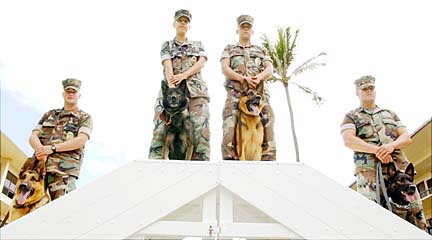


|
Marine security When 8-year-old Brit sits down and looks at him, Marine Lance Cpl. James Davern takes notice.
goes to trained dogs
Teams of canines and handlers
travel the world to sniff out
drugs and bombsBy Gregg K. Kakesako
gkakesako@starbulletin.comThat's because Brit is a German shepherd specially trained by his Marine Corps handlers to detect explosives.
Earlier this year Davern, 21, and Brit were deployed for nearly three months to Bagram Air Base in Afghanistan to work with Army military police to screen and search all vehicles entering the military compound north of Kabul. They also guarded prisoners who eventually were taken to Cuba.
"We searched a lot of gas trucks," said Davern, a member of the military working dogs section at Marine Corps Base Hawaii at Kaneohe Bay.
"In one instance we were searching gas trucks at the gate just before noon," Davern added. "Three pulled up to the gate where we had laid concertina wire across the road. We had all the drivers get out.
"Brit suddenly became interested in the middle truck and sat down and just looked at me."
Davern described Brit's actions as a passive response, meaning the dog had found something interesting. "We cleared the area. These were gas trucks and so we considered them dangerous and called EOD (explosive ordnance disposal) experts. They came real quickly and took the trucks away."
Davern didn't know what was found.

|
On another occasion Brit got interested in one of the tubes sticking out of a gas truck, Davern said."Again he just sat there and when we examined it, we found white putty stuck on the nozzle. We didn't want to risk it and so we called EOD again and they drove the truck away."
Brit is one of 17 Marine Corps working dogs who can, along with their handlers, be sent anywhere in the world, said Sgt. Justin Stephenson, the acting noncommissioned officer in charge of unit. All military working dogs are trained at the 341st Training Squadron at Lackland, fondly called the "Dog School." In addition to the Department of Defense training requirements, the Dog School also trains bomb dogs for the Federal Aviation Administration.
Military working dogs have long been an integral part of the military since World War I. The dogs originally were part of the Army's Quartermaster Corps and a diversity of breeds where accepted. The dogs of choice were the German shepherd and the Doberman pinscher. These dogs are commonly referred to as war dogs; however, the correct term is military working dogs.
In Vietnam alone, there were 3,895 military working dogs, almost all of them pure-bred German shepherds. These dogs served as scouts, sentries, trackers, mine detectors, and tunnel explorers.
1st Lt. David Jones, the unit's operations officer, said the 16 men and one woman handler here are even called to help local law enforcement officials.
"A team was sent to Maui recently to help locate a missing person," Jones said.
After Davern arrived at Kaneohe last year, he and Brit were sent to Molokai to help with the search for 72-year-old Wallace Silva, who had dementia and didn't return home.
"He was an elderly man who suffered with Alzheimer's disease who would go on walks," Davern said. "Unfortunately, this time working with a helicopter we found his decomposed body."
Stephenson added that besides providing security for the Kaneohe Bay installation, the dogs and their handlers are on call to support the Secret Service, Customs Service and Justice Department.
Cpl. Brett Jeanselme, 23, and his 4-year-old Belgium Malinois, Max, spent 78 days in El Paso this spring manning checkpoints at the Mexico-U.S. border with customs officials. Max is trained to detect narcotics, and they are credited with stopping vehicles suspected of carrying more than $1.5 million of illegal drugs into the United States. Max was credited with detecting more than 1,750 pounds of illegal drugs while working at the border crossings in El Paso.
During one week alone, the team found 10 loads of drugs in vehicles attempting to enter the United States.
"The ingenuity of these drug dealers," said Jeanselme, who has been in the Marine Corps for three years, "is impressive."
By law, the military cannot make civilian arrests, so once a vehicle appears to be suspicious Jeanselme had to turn over the final search to local law enforcement.
Lance Cpl. Charles Byers, his 5-year-old German shepherd, Art, Lance Cpl. Lynn Robbins and her 4-year-old German shepherd, Baro, spent seven months in Saudi Arabia earlier this year.
Robbins, 25, was assigned to Eskan Village near Riyadh which at the time of her deployment was being transferred from Air Force to Army control.
"Our job was to search every vehicle that came through the gate. That amounted to about 60 to 70 vehicles a day and more than 1,000 vehicles every month," Robbins said.
Byers said there were several "close calls" when he and Art were on duty.
"There is a high concentration of explosives in the dust because of past action there," said Byers, who has been in the Marine Corps for two years.
"Sometimes the dogs pick this up and go into alert. At that point we call EOD and they come in and tell us what it was the dogs found."